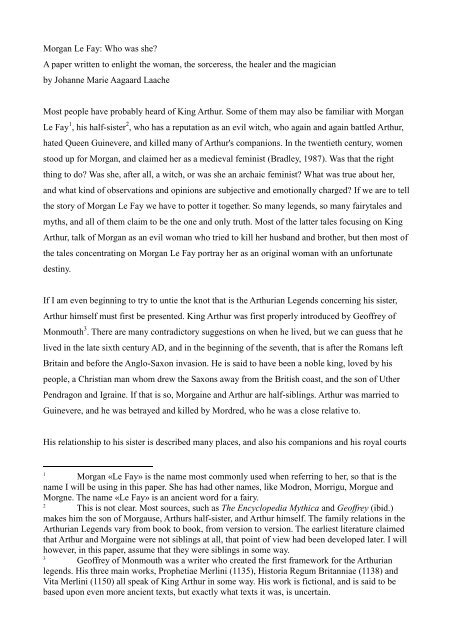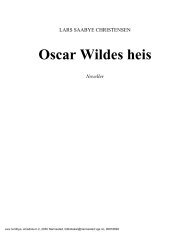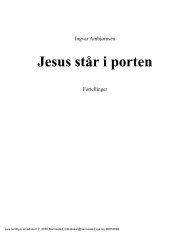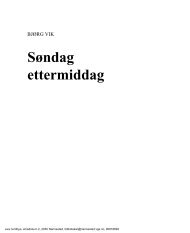Morgan Le Fay: Who was she? A paper written to enlight the woman ...
Morgan Le Fay: Who was she? A paper written to enlight the woman ...
Morgan Le Fay: Who was she? A paper written to enlight the woman ...
You also want an ePaper? Increase the reach of your titles
YUMPU automatically turns print PDFs into web optimized ePapers that Google loves.
<strong>Morgan</strong> <strong>Le</strong> <strong>Fay</strong>: <strong>Who</strong> <strong>was</strong> <strong>she</strong>?<br />
A <strong>paper</strong> <strong>written</strong> <strong>to</strong> <strong>enlight</strong> <strong>the</strong> <strong>woman</strong>, <strong>the</strong> sorceress, <strong>the</strong> healer and <strong>the</strong> magician<br />
by Johanne Marie Aagaard Laache<br />
Most people have probably heard of King Arthur. Some of <strong>the</strong>m may also be familiar with <strong>Morgan</strong><br />
<strong>Le</strong> <strong>Fay</strong> 1 , his half-sister 2 , who has a reputation as an evil witch, who again and again battled Arthur,<br />
hated Queen Guinevere, and killed many of Arthur's companions. In <strong>the</strong> twentieth century, women<br />
s<strong>to</strong>od up for <strong>Morgan</strong>, and claimed her as a medieval feminist (Bradley, 1987). Was that <strong>the</strong> right<br />
thing <strong>to</strong> do? Was <strong>she</strong>, after all, a witch, or <strong>was</strong> <strong>she</strong> an archaic feminist? What <strong>was</strong> true about her,<br />
and what kind of observations and opinions are subjective and emotionally charged? If we are <strong>to</strong> tell<br />
<strong>the</strong> s<strong>to</strong>ry of <strong>Morgan</strong> <strong>Le</strong> <strong>Fay</strong> we have <strong>to</strong> potter it <strong>to</strong>ge<strong>the</strong>r. So many legends, so many fairytales and<br />
myths, and all of <strong>the</strong>m claim <strong>to</strong> be <strong>the</strong> one and only truth. Most of <strong>the</strong> latter tales focusing on King<br />
Arthur, talk of <strong>Morgan</strong> as an evil <strong>woman</strong> who tried <strong>to</strong> kill her husband and bro<strong>the</strong>r, but <strong>the</strong>n most of<br />
<strong>the</strong> tales concentrating on <strong>Morgan</strong> <strong>Le</strong> <strong>Fay</strong> portray her as an original <strong>woman</strong> with an unfortunate<br />
destiny.<br />
If I am even beginning <strong>to</strong> try <strong>to</strong> untie <strong>the</strong> knot that is <strong>the</strong> Arthurian <strong>Le</strong>gends concerning his sister,<br />
Arthur himself must first be presented. King Arthur <strong>was</strong> first properly introduced by Geoffrey of<br />
Monmouth 3 . There are many contradic<strong>to</strong>ry suggestions on when he lived, but we can guess that he<br />
lived in <strong>the</strong> late sixth century AD, and in <strong>the</strong> beginning of <strong>the</strong> seventh, that is after <strong>the</strong> Romans left<br />
Britain and before <strong>the</strong> Anglo-Saxon invasion. He is said <strong>to</strong> have been a noble king, loved by his<br />
people, a Christian man whom drew <strong>the</strong> Saxons away from <strong>the</strong> British coast, and <strong>the</strong> son of U<strong>the</strong>r<br />
Pendragon and Igraine. If that is so, Morgaine and Arthur are half-siblings. Arthur <strong>was</strong> married <strong>to</strong><br />
Guinevere, and he <strong>was</strong> betrayed and killed by Mordred, who he <strong>was</strong> a close relative <strong>to</strong>.<br />
His relationship <strong>to</strong> his sister is described many places, and also his companions and his royal courts<br />
1 <strong>Morgan</strong> «<strong>Le</strong> <strong>Fay</strong>» is <strong>the</strong> name most commonly used when referring <strong>to</strong> her, so that is <strong>the</strong><br />
name I will be using in this <strong>paper</strong>. She has had o<strong>the</strong>r names, like Modron, Morrigu, Morgue and<br />
Morgne. The name «<strong>Le</strong> <strong>Fay</strong>» is an ancient word for a fairy.<br />
2 This is not clear. Most sources, such as The Encyclopedia Mythica and Geoffrey (ibid.)<br />
makes him <strong>the</strong> son of Morgause, Arthurs half-sister, and Arthur himself. The family relations in <strong>the</strong><br />
Arthurian <strong>Le</strong>gends vary from book <strong>to</strong> book, from version <strong>to</strong> version. The earliest literature claimed<br />
that Arthur and Morgaine were not siblings at all, that point of view had been developed later. I will<br />
however, in this <strong>paper</strong>, assume that <strong>the</strong>y were siblings in some way.<br />
3 Geoffrey of Monmouth <strong>was</strong> a writer who created <strong>the</strong> first framework for <strong>the</strong> Arthurian<br />
legends. His three main works, Prophetiae Merlini (1135), His<strong>to</strong>ria Regum Britanniae (1138) and<br />
Vita Merlini (1150) all speak of King Arthur in some way. His work is fictional, and is said <strong>to</strong> be<br />
based upon even more ancient texts, but exactly what texts it <strong>was</strong>, is uncertain.
elations <strong>to</strong> her. For example, in Lawhead (1996), Myrddin or Merlin, Arthurs good friend and<br />
consultant, says this about her:<br />
It is this that is her downfall. O Great Light! This is her infirmity. The Queen of <strong>the</strong> Air and<br />
<strong>the</strong> Darkness can never grant herself fear, <strong>she</strong> cannot admit it's existence, not even <strong>to</strong> herself.<br />
She must always display herself as if <strong>she</strong> has <strong>the</strong> powers <strong>she</strong> is really lacking. She seems <strong>to</strong><br />
be capable of doing all that is really impossible for her. (p. 99)<br />
In <strong>the</strong> very same book it is spoken of a Holy Grail, <strong>the</strong> same Grail that Josef of Arima<strong>the</strong>a<br />
supposedly brought <strong>to</strong> Britannia, that is supposed <strong>to</strong> be a great weapon <strong>to</strong> defeat this evil <strong>woman</strong>,<br />
<strong>Morgan</strong> <strong>Le</strong> <strong>Fay</strong>. I will return <strong>to</strong> <strong>the</strong> subject of <strong>Morgan</strong> <strong>Le</strong> <strong>Fay</strong> and her faith and religion later in this<br />
<strong>paper</strong>.<br />
What did Arthur himself think of her? In Malory (1994), Arthur speaks <strong>to</strong> her husband King Uriens<br />
about her, after <strong>she</strong> has sent his son and her lover Accolon <strong>to</strong> fight Arthur:<br />
Then <strong>was</strong> <strong>the</strong> king [Arthur] wonderly wroth, more than he <strong>was</strong> <strong>to</strong>-forehand, and said un<strong>to</strong><br />
King Uriens, My sister, your wife, is always about <strong>to</strong> betray me, and well I wot ei<strong>the</strong>r ye, or<br />
my nephew, your son, is of counsel with her <strong>to</strong> have me destroyed; but as for you, said <strong>the</strong><br />
king <strong>to</strong> King Uriens, I deem not greatly that ye be of her counsel, for Accolon confessed <strong>to</strong><br />
me by his own mouth, that <strong>she</strong> [<strong>Morgan</strong>] would have destroyed you as well as me(...)<br />
(ch. 16, p. 126).<br />
As this is a <strong>to</strong>ld as a saga, <strong>the</strong>re is not much feeling in it, and it is all said in a very matter-of-fact-<br />
way. But in <strong>the</strong> same fashion as o<strong>the</strong>r tales, it is clear that <strong>she</strong> had done something <strong>to</strong> harm him. Her<br />
betrayals against him are obviously as many and as various as <strong>the</strong> literature mentioning it.<br />
What <strong>was</strong> her purposes? Did <strong>she</strong> at all have any, <strong>was</strong> <strong>she</strong> determined? Did <strong>she</strong> succeed? It varies,<br />
because <strong>the</strong> purposes of <strong>Morgan</strong> changes with everyone who writes about her. To Geoffrey (ibid.),<br />
<strong>she</strong> <strong>was</strong> one of nine sisters, <strong>the</strong> leader of <strong>the</strong>m, fur<strong>the</strong>rmore <strong>she</strong> <strong>was</strong> a shapeshifter and a healer. She<br />
did not have any blood relations <strong>to</strong> Arthur, and equally, <strong>she</strong> didn't try <strong>to</strong> harm him in any way. In<br />
Chrétien de Troyes' Erec and Enide 4 , <strong>she</strong> <strong>was</strong> primarily a healer and Arthur's sister, however, in this<br />
book <strong>she</strong> is not an important character.<br />
A hundred years later, in <strong>the</strong> early 13 th century, <strong>she</strong> changes in<strong>to</strong> some kind of seductress in The<br />
4 De Troyes <strong>was</strong> also a medieval poet who wrote Erec and Enide in 1140. You will find <strong>the</strong><br />
sources I have used <strong>to</strong> understand his works in <strong>the</strong> Webgraphy.
Vulgate Cycle 5 , who is bitter <strong>to</strong>wards Queen Guinevere and tries <strong>to</strong> reveal <strong>the</strong> Queen's sexual<br />
relationship with <strong>the</strong> knight Lancelot. She tries <strong>to</strong> split up Arthur and Guinevere and seduce<br />
Lancelot, but it does not succeed. Can one person have so many personalities?<br />
In a children's book by Crossley-Holland (1998), it says:<br />
The good <strong>Morgan</strong> ruled <strong>the</strong> island west of England known as Avalon. She <strong>was</strong> <strong>the</strong> first in a<br />
sisterhood consisting of nine healers, and when Arthur got badly wounded, <strong>she</strong> <strong>to</strong>ok him <strong>to</strong><br />
Avalon and promised <strong>to</strong> cure him. (...) This good <strong>Morgan</strong> had magic powers: <strong>she</strong> could fly,<br />
<strong>she</strong> could change shape, and <strong>she</strong> <strong>was</strong> also a gifted poet and musician. (...)The evil <strong>Morgan</strong><br />
<strong>was</strong> a fascinating, but dangerous witch, and a enemy of Camelot 6 . She fell in love with<br />
Merlin, and learned <strong>to</strong> practice magic. She <strong>was</strong> jealous of Arthur, so <strong>she</strong> s<strong>to</strong>le his scabbard,<br />
and after <strong>the</strong> King killed one of her many lovers, <strong>she</strong> tried <strong>to</strong> murder him (p. 78).<br />
Is is that simple, or is it just an attempt at making a logical explanation <strong>to</strong> her schizophrenia? That<br />
<strong>the</strong> good <strong>Morgan</strong> <strong>Le</strong> <strong>Fay</strong> is <strong>the</strong> one mentioned in <strong>the</strong> works of Geoffrey (ibid.), <strong>the</strong> work of Chrétien<br />
(ibid.) and <strong>the</strong> one <strong>the</strong> 60's feminists loved and cheri<strong>she</strong>d as a symbol of women, and <strong>the</strong> bad<br />
<strong>Morgan</strong> is <strong>the</strong> one who tries <strong>to</strong> kill Arthur, steal his sword, his scabbard and his best friend?<br />
However, it is an important point that it is said that <strong>she</strong> learned <strong>to</strong> practice magic, and that <strong>she</strong> <strong>was</strong> a<br />
healer. It is safe <strong>to</strong> say that <strong>she</strong> had healing powers, as all of <strong>the</strong> sources can agree on that point. She<br />
<strong>was</strong> not a Christian, at least not in <strong>the</strong> way that <strong>the</strong> Christian priests were. Not very long before<br />
Arthur is said <strong>to</strong> have lived, <strong>the</strong> Romans left Britain after <strong>the</strong>y had interfered for many centuries.<br />
What <strong>the</strong>y left <strong>was</strong> a country that <strong>was</strong> about <strong>to</strong> be christianized. They had left enough believing men<br />
and women behind <strong>to</strong> finish <strong>the</strong>ir task. <strong>Morgan</strong> <strong>Le</strong> <strong>Fay</strong> <strong>was</strong> said <strong>to</strong> be a witch by many. Is this<br />
because <strong>she</strong> <strong>was</strong> not Christian?<br />
A brief account: <strong>Morgan</strong> <strong>was</strong>, or <strong>was</strong> not <strong>the</strong> half-sister of Arthur. In <strong>the</strong> very first Arthurian legend,<br />
<strong>she</strong> <strong>was</strong> merely a healer, a <strong>woman</strong> with special powers, and <strong>she</strong> had many qualities we humans do<br />
not have. Was <strong>she</strong> some kind of a supernatural creature, a fairy, as <strong>the</strong> name <strong>Le</strong> <strong>Fay</strong> suggests? The<br />
understanding of <strong>Morgan</strong> <strong>Le</strong> <strong>Fay</strong> has changed during <strong>the</strong> centuries from a magician or simply a<br />
5 The Vulgate Cycle is a collection of texts which we can presume originally sprung out<br />
from one text. Several authors, amongst <strong>the</strong>m Cisternian Monks, wrote additions, comments and so<br />
on. It is no longer possible <strong>to</strong> see what <strong>was</strong> <strong>the</strong> original piece and what has been added by many<br />
o<strong>the</strong>rs later, and one cannot even say who <strong>the</strong> authors were.<br />
6 Camelot: <strong>the</strong> capital of King Arthur's kingdom; according <strong>to</strong> <strong>the</strong> legend, truth and<br />
goodness and beauty reigned <strong>the</strong>re. (http://www.websters-online-dictionary.org/)
wise <strong>woman</strong>, <strong>to</strong> a destructive nihilist 7 who wi<strong>she</strong>d nothing but <strong>the</strong> worst for everyone. Later,<br />
feminists found out that <strong>she</strong> <strong>was</strong> a great symbol of success and liberty without a man, and as a<br />
<strong>woman</strong> with stronger will that many of <strong>the</strong> men <strong>she</strong> knew, related <strong>to</strong>, loved and fought. In Bradley<br />
(1987), <strong>Morgan</strong> says:<br />
In my time I have been called many things: sister, lover, priestess, wise-<strong>woman</strong>, queen.<br />
Now in truth I have come <strong>to</strong> be a wise-<strong>woman</strong>, and a time may come when <strong>the</strong>se things may<br />
need <strong>to</strong> be known. But I sober truth, I think it is <strong>the</strong> Christians who will tell <strong>the</strong> last tale. For<br />
ever <strong>the</strong> world of Fairy drifts fur<strong>the</strong>r from <strong>the</strong> world in which <strong>the</strong> Christ holds sway. I have<br />
no quarrel with <strong>the</strong> Christ, only with his priest, who call <strong>the</strong> Great Goddess a demon and<br />
deny that <strong>she</strong> ever held power in this world. At best, <strong>the</strong>y say that her power <strong>was</strong> of Satan.<br />
Or else <strong>the</strong>y clo<strong>the</strong>d her in blue robe of <strong>the</strong> Lady of Nazareth – who indeed had power in her<br />
way, <strong>to</strong>o – and say that <strong>she</strong> <strong>was</strong> ever virgin. But what can a virgin know of <strong>the</strong> sorrows and<br />
travail of mankind? (p. 5).<br />
Her belief in something beyond Christ, or something that <strong>was</strong> not Christ, and her supernatural<br />
abilities is somewhat confirmed by Mallory (ibid.) (not a quotation from <strong>the</strong> original manuscript):<br />
<strong>Morgan</strong> <strong>Le</strong> <strong>Fay</strong> never did get married, but sent <strong>to</strong> a school in a convent, where <strong>she</strong> became a<br />
great and skilful master of magic.<br />
In later medieval literature, monks make her evil, and turn her actions in<strong>to</strong> bad, blasfemic plots. She<br />
is said <strong>to</strong> have betrayed Arthur in many different ways, but in <strong>the</strong> end, when Arthur is deadly<br />
wounded, <strong>she</strong> takes him <strong>to</strong> Avalon, where he stays, and no one knows whe<strong>the</strong>r he lived or died<br />
<strong>the</strong>re. About this, Geoffrey of Monmouth writes in his book His<strong>to</strong>ry of <strong>the</strong> Kings of Britain:<br />
And even <strong>the</strong> renowned king Arthur himself <strong>was</strong> mortally wounded; and being carried<br />
<strong>the</strong>nce <strong>to</strong> <strong>the</strong> isle of Avallon <strong>to</strong> be cured of his wounds, he gave up <strong>the</strong> crown of Britain <strong>to</strong><br />
his kinsman Constantine, <strong>the</strong> son of Cador, duke of Cornwall.<br />
Can this be said <strong>to</strong> be <strong>Morgan</strong> <strong>Le</strong> <strong>Fay</strong>? Or is <strong>the</strong> best explanation simply that <strong>Morgan</strong> <strong>Le</strong> <strong>Fay</strong> <strong>was</strong><br />
both <strong>the</strong> Good and <strong>the</strong> Bad, and that no line of demarcation can be drawn? Different s<strong>to</strong>ries,<br />
interpretations and comprehensions throughout <strong>the</strong> years have created different pictures and<br />
dissimilar empathies. If one will only read <strong>the</strong> s<strong>to</strong>ry through <strong>the</strong> eyes of <strong>the</strong> champion of <strong>the</strong> cause<br />
of equal rights for men and women, Marion Zimmer Bradley, we will see <strong>the</strong> men as barbarians<br />
who did nothing but raping women, eating and drinking when not fighting and killing. But if we<br />
7 Nihilist: a belief that all political and religious organizations are bad, or a system of thought<br />
which says that <strong>the</strong>re are no principles or beliefs which have any meaning or can be true.<br />
(http://dictionary.cambridge.org/define.asp?key=53723&dict=CALD)
will only read s<strong>to</strong>ries such as Arthur by Lawhead (ibid.), <strong>the</strong> women will play no roles at all, and<br />
<strong>the</strong> only <strong>woman</strong> standing out will be <strong>Morgan</strong> <strong>Le</strong> <strong>Fay</strong>, with a wicked <strong>to</strong>ngue and a habit of<br />
conspiring against <strong>the</strong> king. To say what that is <strong>the</strong> truth is not simple, and <strong>the</strong> fact that <strong>the</strong> sources<br />
are fiction, fantasy and fairy-tales does not make it easier.<br />
To interpret someone, a mythical person, is subjective. Our understanding of his<strong>to</strong>ry is not alike. We<br />
see <strong>the</strong> same events with different eyes, ideas and expectations. Most of all, what we want <strong>to</strong> see is<br />
what we see. When we see <strong>the</strong> ancient his<strong>to</strong>ry, we see what we are <strong>to</strong>ld <strong>to</strong> see. There are no proofs<br />
of any kind that <strong>Morgan</strong> <strong>Le</strong> <strong>Fay</strong> existed, and we even doubt <strong>the</strong> life of King Arthur. To figure out<br />
her relations <strong>to</strong> King Arthur, <strong>the</strong> Knights of <strong>the</strong> Round Table, Queen Guinevere, Sir Mordred and<br />
<strong>the</strong> priests that condemned her later, is not an easy task. The name King Arthur may tell you<br />
something that it does not tell me, and <strong>the</strong> name <strong>Morgan</strong> <strong>Le</strong> <strong>Fay</strong>, Morgaine, Morrighan, Morgian or<br />
Morgen may give me certain thoughts and associations that are invisible <strong>to</strong> you. To <strong>the</strong> Cistercian<br />
monks, <strong>Morgan</strong> <strong>was</strong> perhaps a sorceress. Her actions were <strong>to</strong> <strong>the</strong>m <strong>the</strong> proofs that her intentions<br />
were evil. She is not like Arthur, as <strong>the</strong>re is a broad consensus about him being one of <strong>the</strong> kings that<br />
changed Britain and <strong>was</strong> worthy of <strong>the</strong> title King, in all its meaning. It is ra<strong>the</strong>r on <strong>the</strong> contrary;<br />
<strong>the</strong>re is no agreement on her character.<br />
So, who <strong>was</strong> <strong>she</strong>? The legend <strong>Morgan</strong> <strong>was</strong> probably not a humble and obedient <strong>woman</strong> such as<br />
most women were in <strong>the</strong> Medieval period. The legend, <strong>Morgan</strong>, <strong>was</strong> an a<strong>the</strong>ist, and if we put all <strong>the</strong><br />
little pieces <strong>to</strong>ge<strong>the</strong>r, a picture can be formed. It may not be correct nor righteous, or just <strong>to</strong> her<br />
actual person. What her affairs with <strong>the</strong> Kings royal court actually were, can only be guessed.<br />
The names one has given her throughout <strong>the</strong> centuries have been many, but <strong>the</strong>y have all in all<br />
meant <strong>the</strong> same, although some expressions have been clearly negative: a <strong>woman</strong> who can follow<br />
her own will, is able <strong>to</strong> heal, and has <strong>the</strong> power <strong>to</strong> carry out something similar <strong>to</strong> magic 8 . Is this<br />
what we really should see her as? Not a libertine 9 , but a radical, a person who forms her own<br />
opinion and belief, especially about religion or politics, ra<strong>the</strong>r than just accepting what is officially<br />
or commonly believed and taught.<br />
If this is most just <strong>to</strong> her character, <strong>to</strong> what we have put <strong>to</strong>ge<strong>the</strong>r with <strong>the</strong> help of countless sources<br />
that is analyzing books, webpages (more or less opinionated and/or unbiased), already formed<br />
opinions, sci-fi books and fantasy literature, <strong>the</strong>n that is what I will se her as. <strong>Morgan</strong> <strong>Le</strong> <strong>Fay</strong> is, and<br />
will probably always be some kind of a mystery. She certainly has confused <strong>the</strong> minds of many, and<br />
8 Magic: a special and exciting quality that makes something seem different from ordinary<br />
things. (http://dictionary.cambridge.org/define.asp?key=48042&dict=CALD)<br />
9 Libertine: a person, usually a man, who lives immorally, having sexual relationships with<br />
many people. (http://dictionary.cambridge.org/define.asp?key=45839&dict=CALD)
let us rest by claiming her, for now, as what we can see her as, without holding <strong>the</strong> opinion narrow<br />
and forever unalterable. A freethinker, a healer and an insurgent, although maybe unintentional.<br />
Bibliography<br />
Bradley, M. Z., (1987), The Mists of Avalon, New York: Ballantine Books.<br />
Crossley-Holland, K., (1998) The King <strong>Who</strong> Was and Will Be: The World of King Arthur and His<br />
Knights, London: Orion Publishing Group. (p. 78)<br />
Lang, A., (2002), King Arthur: Tales from <strong>the</strong> Round Table, Mineola, New York: Dover<br />
Publications Inc..<br />
Lawhead, S., (1996), The Pendragon Cycle: Arthur, Glasgow, Scotland: HarperCollins Publi<strong>she</strong>rs.<br />
Malory, sir T., (1994), <strong>Le</strong> Morte d'Arthur, New York: Random House Inc..<br />
Webgraphy<br />
Britannia Staff Article, <strong>Morgan</strong> <strong>Le</strong> <strong>Fay</strong>, Britannia.com, LLC (2001). [on-line]<br />
http://www.britannia.com/his<strong>to</strong>ry/biographies/morgan.html, 14. Mar. 2009.<br />
Clegg, D., Mordred, Bastard Son, Jan. 1, 2006. [on-line]<br />
http://www.douglasclegg.com/mordred.html, 14. Mar. 2009.<br />
Dawn, A., 08. Aug. 2009, Lady Gryphon's Mythical Realm: <strong>Morgan</strong> <strong>Le</strong> <strong>Fay</strong>, based on Ancient<br />
Myth. [on-line]<br />
http://www.mythicalrealm.com/legends/morgan_le_fay.html, 13. Mar. 2009.<br />
DDT Media Productions, Ltd., King Arthur: A Man for <strong>the</strong> Ages, DW and DDTMedia Productions,<br />
Ltd. (2000). [on-line]<br />
http://www.geocities.com/Capi<strong>to</strong>lHill/4186/Arthur/htmlpages/kingarthurpeople.html, 13. Mar.<br />
2009.
Holloway, P., Caerleon Net: Geoffrey of Monmouth, His<strong>to</strong>ria Regum Brittaniae. [on-line]<br />
http://www.caerleon.net/his<strong>to</strong>ry/geoffrey/, 20. Mar. 2009.<br />
Kelly, E. S., 05. Mar. 2009, Your Inner Goddess: <strong>Morgan</strong> <strong>Le</strong> <strong>Fay</strong>. [on-line]<br />
http://www.yourinnergoddess.net/Morrigan-Morgaine-<strong>Morgan</strong>-<strong>Le</strong>-<strong>Fay</strong>.html, 14. Mar. 2009.<br />
Lang, A., 24. Mar. 2009, Tales of The Round Table: How <strong>Morgan</strong> <strong>Le</strong> <strong>Fay</strong> Tried To Kill King Arthur.<br />
[on-line]<br />
http://www.sacred-texts.com/neu/trt/trt09.htm, 20. Mar. 2009.<br />
Lupack, A. & Lupack, B.T., 06. Feb. 2009, The Camelot Project at <strong>the</strong> University of Rochester:<br />
King Arthur & The Knights of The Round Table: O<strong>the</strong>r Characters in Arthurian <strong>Le</strong>gends. [on-line]<br />
http://www.kingarthursknights.com/o<strong>the</strong>rs/morganlefay.asp, 20. Mar. 2009.<br />
Lupack, A. & Lupack, B.T., 06. Feb. 2009, The Camelot Project at <strong>the</strong> University of Rochester:<br />
<strong>Morgan</strong> <strong>Le</strong> <strong>Fay</strong>. [on-line]<br />
http://www.lib.rochester.edu/camelot/morgmenu.htm, 13. Mar. 2009.<br />
Rise, B. E., 20. Jun. 2000, Encyclopedia Mythica: Geoffrey of Monmouth. [on-line]<br />
http://www.pan<strong>the</strong>on.org/articles/g/geoffrey_of_monmouth.html, 09. Apr. 2009.<br />
Rise, B. E., 01. Aug. 2001, Encyclopedia Mythica: Merlin. [on-line]<br />
http://www.pan<strong>the</strong>on.org/articles/m/merlin.html, 13. Mar. 2009.<br />
Rise, B. E., 25. Nov. 2003, Encyclopedia Mythica: <strong>Morgan</strong> <strong>Le</strong> <strong>Fay</strong>. [on-line]<br />
http://www.pan<strong>the</strong>on.org/articles/m/morgan_le_fay.html, 13. Mar. 2009.<br />
Stagliano, L., Arthurian <strong>Le</strong>gends: Queen <strong>Morgan</strong> <strong>Le</strong> <strong>Fay</strong>, a Student Assignment. [on-line]<br />
http://csis.pace.edu/grendel/projs993a/arthurian/morgan2.htm, 20. Mar. 2009.<br />
Taylor, P., <strong>Morgan</strong> <strong>Le</strong> <strong>Fay</strong> in Arthurian <strong>Le</strong>gends, Patrick Taylor (2004-2007). [on-line]<br />
http://www.arthurian-legend.com/more-about/more-about-arthur-8.php, 13. Mar. 2009.<br />
Taylor, P., <strong>Le</strong> Morte d'Arthur, Patrick Taylor (2004-2007). [on-line]<br />
http://www.arthurian-legend.com/le-mort-darthur.php, 13. Mar. 2009.
Wikipedia The Free Encyclopedia, 21. Mar. 2009, <strong>Morgan</strong> <strong>Le</strong> <strong>Fay</strong>. [on-line]<br />
http://en.wikipedia.org/wiki/<strong>Morgan</strong>_le_<strong>Fay</strong>, 13. Mar. 2009.<br />
Wikipedia The Free Encyclopedia, 11. Mar. 2009, Morrígan. [on-line]<br />
http://en.wikipedia.org/wiki/M%C3%B3rr%C3%ADgan, 15. Mar. 2009.<br />
Wikipedia The Free Encyclopedia, 11. Oct. 2008, Wikiquote: Geoffrey of Monmouth. [on-line]<br />
http://en.wikiquote.org/wiki/Geoffrey_of_Monmouth, 14. Mar. 2009.<br />
Annotated Bibliography<br />
Wikipedia The Free Encyclopedia, http://en.wikipedia.org/wiki/Main_Page<br />
Wikipedia is a free, web-based, multilingual encyclopedia that everyone can access, and that can be edited and <strong>written</strong><br />
by whomever wi<strong>she</strong>s <strong>to</strong> do so. It is <strong>written</strong> in collaboration among volunteers around <strong>the</strong> world, and <strong>the</strong>re are<br />
administra<strong>to</strong>rs who edit, censor, delete and report articles every day. Articles, or parts of it, that are improper or<br />
incorrect are removed or marked as «in need of tidying-up». Wikipedia has, however, no quality assurance, and <strong>the</strong>re is<br />
always information and articles that haven't been edited. Eg. In Oc<strong>to</strong>ber last year, a Wikipedia-article about cellular<br />
respiration said that it <strong>was</strong> unwise <strong>to</strong> keep plants in one's bedroom, as <strong>the</strong>y during <strong>the</strong> nighttime transform oxygen in<strong>to</strong><br />
carbon dioxide. The articles vary a lot in quality and reliability, but <strong>the</strong> source can be used if it is used critically and<br />
with care.<br />
Kelly, E. S., (14 March 2009), Your Inner Goddess: <strong>Morgan</strong> <strong>Le</strong> <strong>Fay</strong>,<br />
http://www.yourinnergoddess.net/Morrigan-Morgaine-<strong>Morgan</strong>-<strong>Le</strong>-<strong>Fay</strong>.html<br />
The website is created by a private person, Erynn Shea Kelly, and it is created <strong>to</strong> put out and show us <strong>the</strong> ancient, or<br />
more modern, goddesses from mythology, legends, myths and fairytales, as well as <strong>to</strong> honour women and <strong>the</strong> female<br />
spirit in general. This makes <strong>the</strong> website quite a bit subjective, and even though it portays itself as serious and well-<br />
informed, in addition <strong>to</strong> being familiar with all of <strong>the</strong>se ancient sources, it is not hard <strong>to</strong> see that some information is<br />
facts, and o<strong>the</strong>rs are just nonsense. It is a source that one must be critical <strong>to</strong>wards, as it shows only a mere piece of <strong>the</strong><br />
<strong>woman</strong> <strong>Morgan</strong> <strong>Le</strong> <strong>Fay</strong>.<br />
Clegg, D., (05. Mar. 2009), Mordred, Bastard Son, http://www.douglasclegg.com/mordred.html<br />
Clegg's book is a book about Mordred, <strong>the</strong> man who betrayed King Arthur, wounded him deadly, and got killed himself,<br />
according <strong>to</strong> many legends. Douglas Clegg has <strong>written</strong> a book based upon <strong>the</strong> rumour that tells us that <strong>Morgan</strong> <strong>Le</strong> <strong>Fay</strong><br />
and King Arthur were, incidentally, <strong>the</strong> parents of Mordred. Clegg writes at http://www.douglasclegg.com/:<br />
To not take an accepted tale at face value, but <strong>to</strong> explore <strong>the</strong> complexity of a fascinating individual's life -- and<br />
<strong>to</strong> dispel <strong>the</strong> myths created by only one version of <strong>the</strong> tale of his existence?
Appendix<br />
The sources that I can find mentioning King Arthur, The Knights of The Round Table, Merlin,<br />
<strong>Morgan</strong> <strong>Le</strong> <strong>Fay</strong>, etc. are not reliable sources, as in sources that have a basis in scientific studies.<br />
They are also often contradic<strong>to</strong>ry, that is, <strong>the</strong>y claim <strong>to</strong> tell <strong>the</strong> truth, and when someone writes <strong>the</strong><br />
excact opposite, who <strong>to</strong> believe? Geoffrey of Monmouth <strong>was</strong> a pseudohis<strong>to</strong>rian and in <strong>the</strong> same way<br />
that Nostradamus <strong>was</strong> a fortune teller, Geoffrey of Monmouth has <strong>written</strong> <strong>the</strong> s<strong>to</strong>ry as he sees it.<br />
Still, many o<strong>the</strong>r books (upon <strong>the</strong> subject) rest on Geoffrey of Monmouth's works, and <strong>the</strong>refore<br />
<strong>the</strong>y will all be included as sources here, though, not scholarly. Even <strong>the</strong> most extreme opinions<br />
have <strong>to</strong> be comprised, as <strong>the</strong>y are also opinions and views.






